What is a Kano Model
The Kano model is a framework designed to prioritize features based on the degree to which they will satisfy the users. In other words, a Kano model helps prioritize features based on how much the feature will aid the users.
In most cases, you will use the Kano Model after you receive customer feedback (VOC)–often implemented along with QFD during the Define phase of DMAIC of a Six Sigma project.
Noriaki Kano first introduced the Kano model in Japan in 1984. After carefully researching customer loyalty and satisfaction, he developed the model to focus on these customer factors.
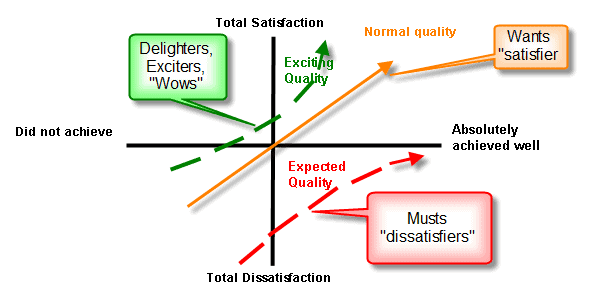
What are the key elements that make the Kano Model effective?
The Kano model analyzes customer needs by diagramming user wants across two axes.
The vertical axis shows satisfaction with your output. The top of the vertical axis represents high satisfaction, and the bottom represents very low user satisfaction.
Similarly, the horizontal axis represents how the goals are achieved or shows the performance of the service. Low performance sits on the left-hand side, and high performance can be found on the right-hand side.
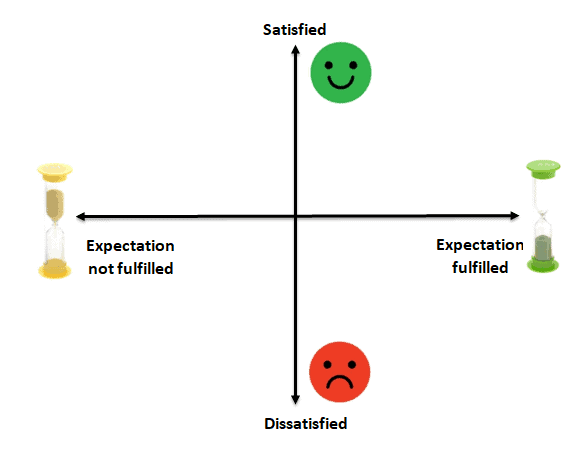
Your clients can be considered delighted, neutral, or dissatisfied, depending on how you perform on each axis.
When Would You Use a Kano Model?
The Kano model can be used in the manufacturing or service industry whenever the product development team prioritizes the features with limited resources and time.
- Identify performance features
- Include basic requirements
- Delight the customer by introducing unexpected features
- When you have limited resources and time
- Avoid unwanted features
5 Categories of Kano Model
3 Features to include
Dissatisfiers: The dissatisfier feature is also called “must be” or the expected basic feature. These are the basic requirements that customer expects as part of a product or service. If these features existed in the product or service, customers would not be happy, but at the same time, if these are not present, then the customer will be disappointed.

Example: When a customer switches on the fan in a hotel room. If it works, the customer won’t even think about it. But if it is not working, then he will be disappointed.
Performance: The performance feature is also called a one-dimensional and desired quality feature. These increase customer satisfaction with the investment. In other words, more of the performance feature will increase customer happiness.
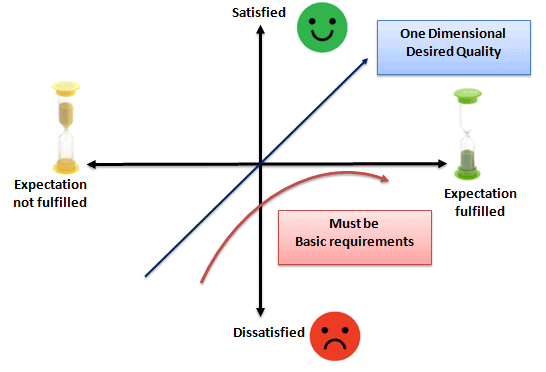
Example: Customer satisfaction will increase in proportion if you serve more variety (with quality) in the hotel’s free breakfast.
Delighters: A delighter is a feature, also called latent requirements, that is not basic and expected but desirable and unexpected. Customers will not be unhappy if they are missing. Particularly, a feature like this goes beyond the consumer’s immediate needs. What is considered a delighter today may be a requirement tomorrow. Cameras on cell phones are a feature that was a delighter at one point but now is a basic requirement.
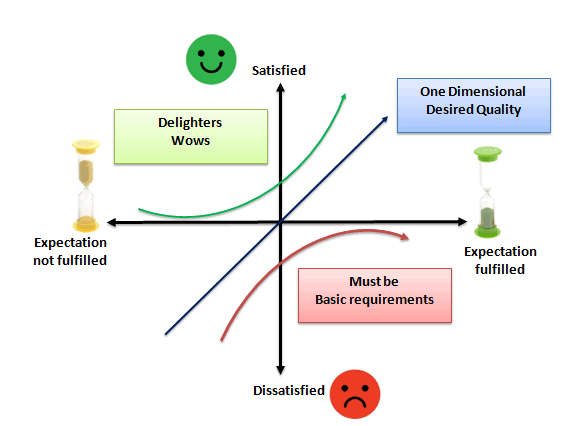
Example: Customers will be delighted if you provide a free room upgrade or give out complimentary toys or bags to the kids at the hotel.
2 Features to avoid
Indifferent: This includes when a customer is indifferent to whether the feature exists or not. In other words, the customer doesn’t care about whether they are present or absent. These unnecessarily add to cost and risk.
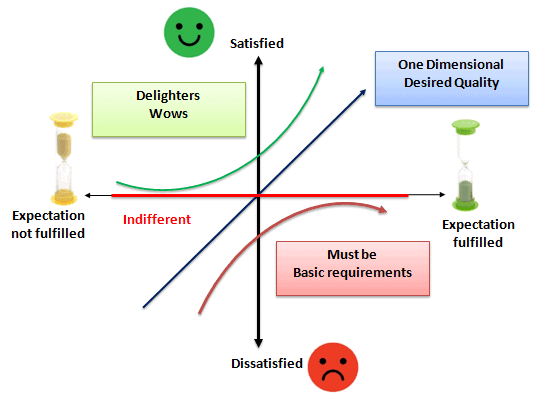
Example: Costly glass flowers placed in the hotel parking lot.
Reverse: The presence of a feature that dissatisfies the customer. In other words, enhance customer satisfaction with the absence of this feature.
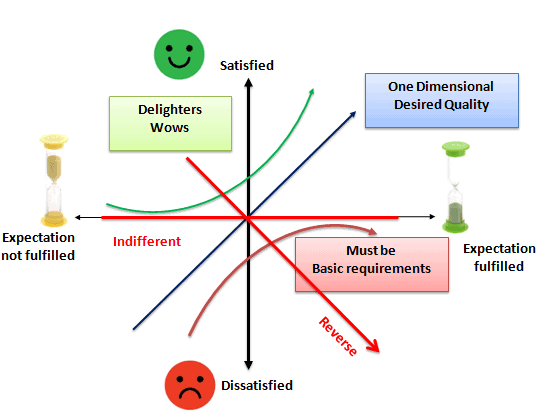
Example: Customers becoming irritated with colored LED lights placed on the hotel grounds.
How could you use a Kano model to influence future strategy?
The quick evaluation of technology and change in customer needs force businesses to predict the requirements upfront and adapt to their operation. In fact, all customer needs are not equal; they have different priorities and attach different meanings to these needs. So, it is the responsibility of the business to understand and predict future requirements.
The Kano Model helps to predict the feature requirements of the customers. The performance feature may be undesired in the future, and also the delighter may become the basic requirement.
Example: CD/DVD drive in a laptop is a delighter feature at one time, which becomes a basic requirement over time. Since customers are expecting slim laptops, nowadays, new generation laptops won’t have the CD/DVD drive in laptops as it becomes an undesired feature.
How to Build a Kano Model
The following is a five-step process to build a Kano Model
Step 1: Identify the Features that need to implement: Create a list of features that have to add to the product or service. In fact, these requirements come from customers, management, or the points from the team brainstorming.
Step 2: Conduct a customer survey: Get customers’ opinions on each feature in a standardized way using two questions. The questions would be functional questions and dysfunctional questions.
- Functional question: Ask a question about how the customer would feel if the product or service had that particular feature.
- Dysfunctional question: Ask a question about how the customer would feel if the product or service did not have that particular feature.

Step 3: Categorize the response: Review the customer response to functional questions and dysfunctional questions for each feature. Compare the functional and dysfunctional to assess the type of requirement.

Where:
- Q-Questionable
- R-Reverse
- I- Indifferent
- M- Must be
- P-Performance
- D-Delighters
Example: Suppose you are asking the customer about a drop-down feature in the reports to select the suppliers, and the customer responds “Expect” for functional and “Dislike” for dysfunctional, then it would be a “Must be “feature.
Step 4: Analyze the data: Summarize all the responses and analyze the highest requirement for each category.
Step 5: Prioritize the Features to implement:
- First, focus on “must be” requirements that customers expect to have. Otherwise, they will be disappointed in their absence.
- Then focus on performance requirements and try to include as many as you can. More performance features increase customer satisfaction.
- Now focus on delighter features to include based on the budget.
- Eliminate any reverse features.
- Finally, ignore all indifferent features as they don’t add any value.
Example of a Kano Model in a DMAIC Project
Example: XYZ is a famous corporate hospital performing the Kano model to prioritize various features based on the degree to which they will satisfy or delight the users.
Step 1: Identify the features that need to implement:
The team listed below five features to add to hospital service to enhance customer satisfaction
- Introduce an online billing system to reduce waiting time.
- Collect insurance process charges from customers during admission for quick processing.
- Introduce two free follow-up visits whose bill is more than 20K.
- Install sensor lighting system for power saving.
- Increase the number of varieties in the patient menu.
Step 2: Conduct customer survey:
Hospital management collected feedback on each feature from 30 patients standardized using two questions, like functional questions and dysfunctional questions.
Step 3: Categorize the response:
The hospital reviewed the customer response to functional questions and dysfunctional questions for each feature.

Step 4: Analyze the data:
Summarized all the responses received from 30 patients and analyzed the highest requirement in each category.

Step 5: Prioritize the features to implement:
- First, focus on “must be” requirements: Feature 1 and Feature 5 – It reduces the billing time and serves good food.
- Then focus on performance requirements: Feature 5 – Customer satisfaction will increase with the number of varieties.
- Now focus on delighter features: Feature 3- Customers delighted with free follow-up visits.
- Eliminate any reverse features: Feature 2: Although it will reduce the processing time, customers are not ready to pay the processing charges during admission.
- Finally, ignore all indifferent features as they don’t add any value: Feature 4- Sensor-based lighting system does not matter to the customers.


Comments (6)
Interesting
Thanks, Sarah.
Great explanation! thank you Ted!
Had not seen the dysfunctional perspective.
Glad to have helped, Barbara.
And thank you for the kind words!
Hi am looking to enroll 12 of my Employees for Green belt six sigma program,
The program is tailored to creat six sigma methodology awareness in my Organization,
I would like to have your details and mode of training as well as the cost and resources to be used.
I look forward to your response.
Thanks
Vince Ottih
Quality Manager(LV)
Unimacts Global LLC
Las Vegas, Nevada
U.S.A
I’ll follow up with you over email, Vince. Thanks for reaching out.